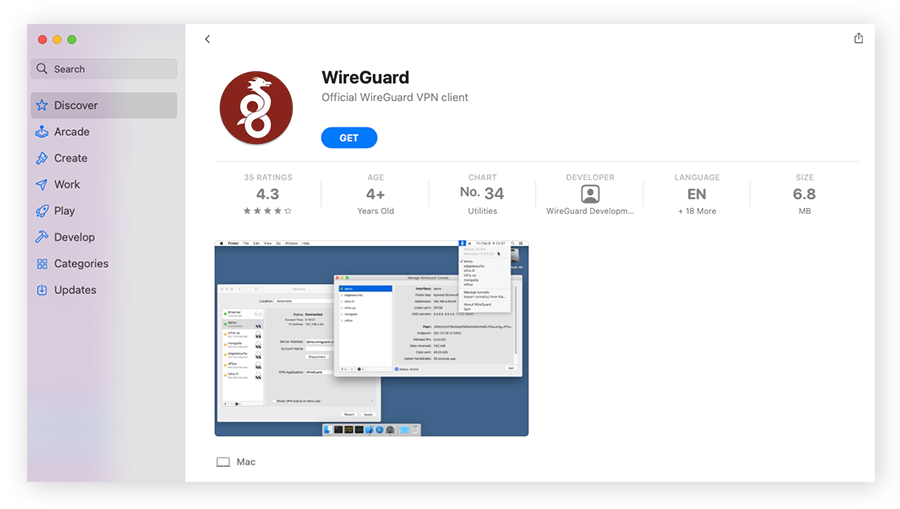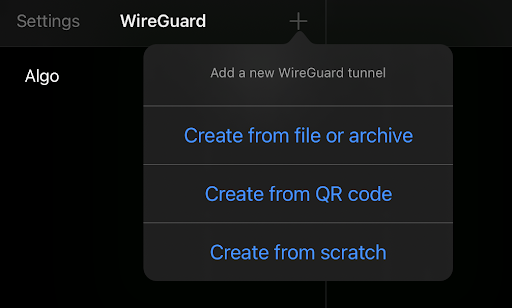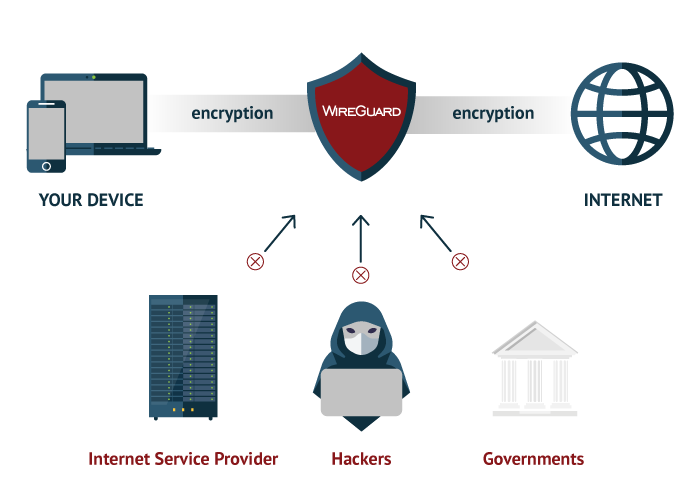What is Wireguard VPN Protocol?
Wireguard is an open-source VPN protocol designed for speed, security, and simplicity. It uses modern cryptography for encrypted data transfer and maintains connections efficiently, even with IP changes.
🤖AI Overview:
Wireguard is an open-source VPN protocol that enhances performance and security over traditional VPN protocols. It establishes a secure encrypted tunnel using modern cryptographic algorithms and manages network connections efficiently, making it faster and easier to configure. Wireguard is widely compatible and increasingly adopted for both personal and business VPN setup.
How does WireGuard work?
Wireguard VPN protocol creates an encrypted tunnel to transfer data, which is encrypted using modern cryptography principles.
It behaves in a way that even IP changes do not affect the connection, meaning a switch in the network will not make you wait for the VPN to reconnect.
It stores the user’s IPs during a session and does not drop the connection if the IP changes.
What port is best for WireGuard?
It uses port 51820 UDP by default.
Can WireGuard do site to site?
Yes. Doing so will enable you to build your private tunnel to surf the web securely.
Is WireGuard replacing other VPN Protocols?
Yes. We can say that the Wireguard protocol will be the sole VPN protocol in the near future.
Despite the WireGuard’s brilliant features, It is still not supported by all VPN providers, which makes the replacement process slow.
Compared to alternatives, WireGuard is faster and helps professionals find potential vulnerabilities and bugs more quickly.
Why is Wireguard better than other VPN protocols?
The key supremacy of Wireguard protocol over others is its light code base. It results in better management, faster debugging, and lower attack possibilities.
The second advantage is its connection speed, which is four times faster than the second VPN protocol on the market.
And the third one is its modern cryptography. So, we can claim that Wireguard is better than other VPN protocols.
Why is WireGuard so fast?
The main reason for Wireguard’s high speed is that it only utilizes UDP, which uses no handshake protocols that slow down the connection.
Who uses WireGuard?
Here is the list of the VPNs that either use or have implemented the Wireguard protocol:
- NordVPN:
NordVPN has implemented Wireguard to its VPN services and named the new protocol “NordLynx.”
This way, the user benefits from Wireguard’s features and avoids its shortcomings. - Mullvad VPN:
Mullvad VPN supports Wireguard protocol, enabling you to import your configs into its application. - Vypr VPN:
In addition to Chameleon™ and other VPN protocols, Vypr has WireGuard® protocol available. - Surfshark:
You can choose between WireGuard®, IKEv2, and OpenVPN to use with Surfshark. - CyberGhost:
The last VPN provider in our list, which utilizes Wireguard protocol, is CyberGhost VPN.
Why use WireGuard?
Wireguard has some outstanding features that make it the best VPN protocol to use and superior to its rivals. These features are:
Speed
Although Wireguard uses userspace, it is four times faster than other VPN protocols in establishing and maintaining connections.
The speed of establishing a connection using this protocol is one to two seconds, while other protocols take five to ten seconds.
Light Code Base
WireGuard, with 4000 lines of code in its codebase, is significantly smaller than IPsec (with 400,000) and OpenVPN/OpenSSL (with 600,000).
99% reduction in code base lines makes it invulnerable to attacks and easier to manage and debug, enhancing its performance.
Ease of deployment
Easy to configure and deploy as SSH? So, you are talking about WireGuard. IT professionals can configure WireGuard as easily as configuring an SSH.
WireGuard client and server are simple to install. After implementing it, you won’t need to handle connections, states, or daemons.
Streamlined design
WireGuard can connect and reconnect quickly when roaming between networks (especially mobile networks). Its design helps it to speed up the VPN connection.
It handles network changes very well. Other VPN protocols sometimes feel brittle or clunky in the same situations.
Security and encryption
WireGuard is highly secure since it uses the latest modern cryptography with secure defaults.
With safety in mind, it uses state-of-the-art cryptography such as ChaCha20, SipHash24, Noise protocol framework, BLAKE2s, HKDF, and Curve25519.
Open Source code
Being open-source helps the Wireguard VPN protocol ensure that features don’t infringe on user privacy and security.
And a large VPN community is ready to fix any issues, audit the code, and improve its design.
Easy to set up
Wireguard is both easy to use and to set up. Users can connect via their VPN application by clicking a button.
Why do people not use WireGuard?
While we told you why people use Wireguard, here are some reasons not to use it.
Not fully complete yet
The first reason you shouldn’t use Wireguard is that it is still incomplete and in progress because of its very young age (released in 2020).
The community and developers are still working on it.
Platforms
Initially, Wireguard is written for Linux and optimizes best for this OS. So you can guess that it best performs on Linux distributions.
On all other platforms it uses userspace, but still is better than other protocols in performance.
Privacy
- Wireguard stores user IPs and, therefore, has static IP addresses.
- Additionally, it utilizes UDP instead of TCP for faster connections, in cost of privacy.
- It does not auto-delete user IPs after disconnection.
- Currently, it does not obfuscate traffic, so ISPs, government, and VPN providers can monitor your traffic.
Unable to bypass censorship
Wireguard cannot connect to port 433 to bypass censorship because it does not use TCP.
Comparing WireGuard with Two Best VPN Protocols
Due to its contemporary methodology, WireGuard has a number of performance and security advantages over earlier VPN protocols.
Let’s dive deeper to compare some of these protocols.
WireGuard vs. OpenVPN
| Wireguard | OpenVpn | |
|---|---|---|
| Speed | Super fast | Moderate |
| Bandwidth (megabits/s) | 1011 | 258 |
| Transfer Protocol | UDP | TCP / UDP |
| Open-source | Yes | Yes |
| Security | Strong | Strong |
| Price | Free | Subscription |
| Code Length | 4/000 lines | 100/000 lines |
| Stability | Very high | High |
At the moment, OpenVPN is the most widely used VPN protocol.
Both OpenVPN and WireGuard are open-source, have a small number of security flaws, and need additional configuration files to be installed on most devices.
The main difference is that WireGuard is far more effective and uses more sophisticated cryptographic libraries.
Additionally, the WireGuard protocol has a slighter impact on battery life than OpenVPN.
WireGuard vs. IPSec/IKEv2
| WireGuard | IPSec/IKEv2 | |
|---|---|---|
| Speed | Super fast | Fast |
| Bandwidth (megabits/s) | 1011 | 825 |
| Transfer Protocol | UDP | UDP |
| Open-source | Yes | No |
| Security | Strong | Strong |
| Price | Free | Free |
| Code Length | 4/000 lines | 400/000 |
| Stability | Very high | Very high |
Business VPNs frequently employ IKEv2/IPsec, which offers a number of encryption techniques.
Although IKEv2/IPsec is a more flexible and faster protocol than WireGuard, IKEv2’s encryption techniques are outdated and, in general, less effective.
The design of IPsec is bulkier and heavier, and because it has more lines of code than other traditional VPN protocols, it is more prone to hacking.
WireGuard Setup
You can install WireGuard on your own VPN server if you don’t want to utilize a commercial VPN package.
Setting up a personal VPN server is challenging for the common user, but WireGuard simplifies it.
For best performance, it is recommended to use Wireguard on Linux distributions like Ubuntu.
By the way, you need to pass nine main steps to set up WireGuard VPN on MacOS:
- Firstly, you need to set up a VPN connection on your computer.
- Download and install WireGuard on your VPN.

- Create client and server keys.
- Create client and server configurations.
- On the server, enable the WireGuard interface.
- Turn on IP forwarding on the server.
- Adjust firewall and server networking configuration.
- Adjust domain name system configuration (DNS).
- Configure the clients on WireGuard.
WireGuard Configuration on mobile
The WireGuard software for mobile devices allows you to scan a QR code rather than painstakingly copying certificates and inputting information.
You may be given a QR code to scan by your VPN service provider or server software.
Hit the plus icon, then select “Create from QR code.”

Conclusion
WireGuard represents a major advancement in VPN technology through its combination of speed, modern cryptography, simplicity, and open-source transparency.
While it is not yet universally adopted and has some limitations in privacy and platform optimization, its benefits make it likely to become the dominant VPN protocol in the near future.
Users and organizations seeking a high-performance, secure VPN solution will find WireGuard to be an excellent choice that is increasingly supported by top VPN providers.
FAQ
2. Why is Wireguard considered faster than other VPN protocols?
Wireguard uses only UDP for connections, avoiding slow handshake protocols. Its lightweight codebase of about 4000 lines allows faster connection establishment and data transfer, making it about four times faster than older VPN protocols.
3. How secure is Wireguard compared to other VPN protocols?
Wireguard employs state-of-the-art modern cryptography, including ChaCha20 and Curve25519, ensuring strong encryption. Its small codebase reduces vulnerabilities, making it more secure and easier to audit than protocols like OpenVPN and IPSec.
4. Which operating systems are compatible with Wireguard?
Wireguard is compatible with Linux, Windows, macOS, iOS, and Android. It is optimized for Linux but performs well on all major platforms by running in userspace.
5. How do I set up Wireguard on my device?
Setting up Wireguard involves installing the client software, generating client and server keys, configuring settings, and enabling the Wireguard interface. Mobile apps simplify setup by allowing QR code scanning for easy configuration.
6. What are the main advantages of using Wireguard over other VPN protocols?
Wireguard offers superior speed, easier configuration, a streamlined and lightweight codebase, strong security features, and reliable network handling, especially when switching networks or roaming.
7. Can Wireguard be used for site-to-site VPN connections?
Yes, Wireguard supports site-to-site VPN setups, enabling secure private tunnels between multiple locations for safer internet browsing and communication.
8. What are some limitations or drawbacks of Wireguard?
Wireguard is still relatively new and under development. It stores user IPs during sessions, which may raise privacy concerns. Additionally, it lacks traffic obfuscation and cannot use TCP to bypass some censorship measures.
9. How does Wireguard compare to OpenVPN and IPSec?
Wireguard is faster, has a smaller and cleaner codebase, and uses more modern cryptographic methods. Unlike IPSec, it is simpler to configure and audit. Compared to OpenVPN, it has less impact on battery life and faster connection speeds.
10. Is Wireguard replacing other VPN protocols in the future?
Wireguard is increasingly adopted due to its advantages and is expected to become the primary VPN protocol. However, full replacement is gradual as some VPN providers have yet to support it fully.
